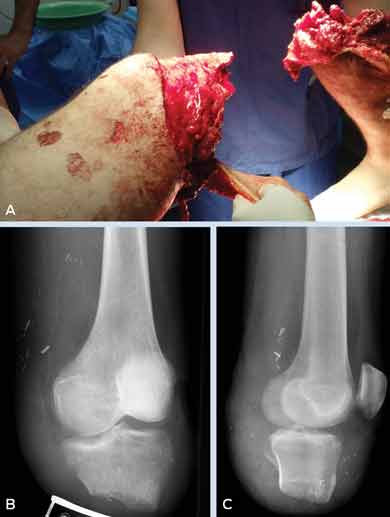This is the first published case series of patients with injuries from watercraft propellers and jet skis. Five patients presented to the level-one trauma centre of Western Australia with such injuries over 10 days during the 2010–2011 Christmas holidays; all required surgery, and all but one sustained multiple, severe injuries. (MJA 2011; 195: 000-000)
A 23-year-old man was injured while he and his colleagues were riding jet skis after a Christmas party. A colleague collided with him at high speed, crushing his left leg between their jet skis and causing a subtotal amputation just below the knee; only a small bridge of skin remained. The leg was deemed unsalvageable and the amputation was completed in theatre (Box). Several debridements and washouts were performed before the stump was covered with a latissimus dorsi flap. Antibiotic therapy with intravenous meropenem and ciprofloxacin was given for 22 days on the advice of a clinical microbiologist.
The patient will require extensive physiotherapy and occupational therapy during his rehabilitation. He will also need a prosthesis, which will be challenging to develop because of the fastidious nature of the flap and the very short stump (Box).
This cluster of incidents occurred over a short period of time in a city whose population has ready access to a range of recreational activities involving watercraft. Western Australia has seen a trend in recent years towards smaller, propeller-driven boats, possibly as a result of the global financial crisis. The number of newly registered large cabin-cruiser boats in WA dropped steadily from 572 in 2006 to 332 in 2010. During the same period, the number of new jet and racing boat purchases remained largely unchanged (17 in 2006 and 18 in 2010, with moderate fluctuations in between these years).1 Furthermore, in the period from December 2006 to March 2011, there were 72 boat and watercraft accidents in WA, seven of which were caused by the propeller (unpublished WA watercraft injury statistics for 2006–2010 held by the Royal Perth Hospital trauma registry). This occurred despite appropriate legislation for licensing, speed restrictions and operating watercraft under the influence of alcohol.
Watercraft and propeller injuries are often characterised by severe initial injury and physiological insult, including severe haemorrhage. The cutting nature and high speed of propellers results in repeated wounding of the body at multiple levels, greatly multiplying the risk of irreparable damage to deep neurovascular structures. Also, serious complications can ensue after the initial damage control period, particularly uncontrollable wound infection, often with unusual bacteria which may not be detected by routine culture methods.2,3 This may necessitate amputation, even if a limb may initially appear to have been saved.
A concept worth mentioning is that of a propeller guard.4 The guard provides a barrier to the cutting edge of the blades and eliminates the risk of a person making contact with a running propeller. We believe that this is still a relatively unknown idea in Australia, and some retailers suggest that uptake may not be universal among new boat owners. Staff at a major Perth boating retailer believe that people purchasing a boat for speed or associated recreational activities like skiing may be deterred by the potential loss of speed.
- 1. Government of Western Australia Department of Transport. Western Australian watercraft registration statistics 2006–2010. Perth: Department of Transport, 2011.
- 2. Noonburg GE. Management of extremity trauma and related infections occurring in the aquatic environment. J Am Acad Orthop Surg 2005; 13: 243-252.
- 3. Carter E, Cain K, Rutland B. Chromobacterium violaceum cellulitis and sepsis following cutaneous marine trauma. Cutis 2008; 81: 269-272.
- 4. Mendez-Fernandez MA. Motorboat propeller injuries. Ann Plast Surg 1998; 41: 113-118.






No relevant disclosures.